
|
7108
S. Alton Way, Unit I |
(303) 758-2728
Home > Tips > Neoprene O-ring
|
Tip: When to use a neoprene o-ring or sealSometimes it is hard to know which elastomer to choose for an application. Depending on the circumstances, neoprene can offer some definite advantages. Here are some points to consider when deciding which elastomer to use. If you need to seal refrigeration fluids, a neoprene o-ring can be a good choice because it has excellent resistance to Freon and ammonia. If you need an o-ring with a good temperature range, neoprene has heat resistance up to 250 degrees F. and remains flexible down to -40 degrees F. Because a neoprene o-ring has this broad temperature range, and because it is inexpensive, it can be used in many general service applications. A neoprene o-ring has outstanding physical strength and resists the tearing and cracking caused by flexing and twisting. With its excellent resistance to sunlight, ozone, oxygen, carbon dioxide and weathering, a neoprene o-ring is an outstanding choice for outdoor applications. Neoprene works well if you need an o-ring with low gas permeation. If you are using silicone oils or greases in your application, neoprene might work well because it has a high resistance to these fluids. Most other elastomers are resistant to either petroleum based lubricants or oxygen, but not both. A neoprene o-ring will serve you well if you need resistance to both of these. If you have an underwater application a neoprene o-ring will provide you with good resistance to water and water solvents at low temperatures. Since neoprene seals have a greater resistance to fire than hydrocarbon based rubbers, they are a good choice for sealing fire doors. If your application calls for rubber to metal bonded parts, neoprene has excellent adhesion qualities and can be successfully bonded to metal to make whatever parts you need. Do not choose neoprene for environments that contain aromatic hydrocarbons (benzene), chlorinated hydrocarbons (trichloroethylene) or polar solvents (ketones, esters, ethers and acetones).
|
We are located in the Denver Technological
Center in a suburb of Denver, Colorado
©1997-2017, Problem Solving Products, Inc.
Website Map | Privacy Statement
| Terms of Use

